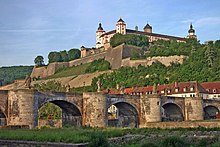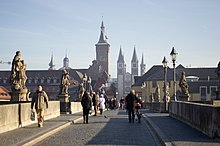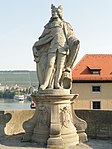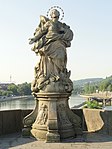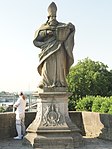Old Main Bridge
Coordinates: 49 ° 47 ′ 35 " N , 9 ° 55 ′ 34" E
| Old Main Bridge | ||
|---|---|---|
| Subjugated | Main | |
| place | Wurzburg | |
| construction | Stone arch bridge | |
| overall length | 185 m | |
| Headroom | 4.45 m (lock) | |
| start of building | 1476 | |
| completion | 1703 | |
| location | ||
|
|
||
| Above sea level | 169 m above sea level NN | |
The Old Main Bridge is the oldest bridge over the Main in Würzburg and a landmark of the city. The building, which began in the 12th century, was Würzburg's only river crossing until 1886. The bridge, part of the east-west passage, connects the old town on the right bank of the Main with the Marienberg fortress opposite at km 252.32 . It is used by pedestrians and cyclists. With its stone figures that characterize the cityscape, the Old Main Bridge, like the Charles Bridge in Prague, continued a tradition that began in Rome with the Angel's Bridge.
history
The first Romanesque stone bridge at this point was built around 1120 under the cathedral and city architect Enzelin, before there was a ferry there. According to the Vita, when the foundations were established, the statues of the pagan Freya sanctuary (now inside the fortress) that had been thrown there by the three missionaries St. Kilian , Kolonat and Totnan were found again. The bridge at that time was partially destroyed in the floods in 1342 and 1442, but was also affected over the years by the so-called Dutch trunks, wooden trunks that were transported floating in the river. Therefore, after almost 350 years of standing, the structure was replaced by a new building, today's bridge.
The new "old" Main Bridge was built from 1476 onwards. In 1488 the stone pillars made of limestone from the shell limestone were completed. The arched bridge superstructures between the pillars were initially wooden structures, also for defense reasons. From 1512 the openings were bridged with stone vaults, which dragged on until 1703 due to lack of money.
Until the 18th century the bridge was fortified by military means and almost entirely built with booths. Until 1869 there was a bridge gate at the western end of the bridge, which Johann Philipp von Greiffenclau zu Vollraths had built according to the design of an unknown architect and for the Balthasar Esterbauer 1701/1702 four now lost statues (two Roman warriors on the east facade and two Amazons on the Western front) and two prince-bishop coats of arms. After the death of Prince-Bishop Christoph Franz von Hutten , who commissioned the artist Anton Clemens Lünenschloß to design a program of figures in 1725, six statues of saints were erected on the south side of the bridge at the end of the 1720s, comparable to the figures on the Charles Bridge Prague . Around 1730, Prince-Bishop Friedrich Carl von Schönborn had six more baroque sandstone figures around 4.5 meters high erected on the north side of the bridge. The figures are located in pillar pulpits and face inward towards the roadway.
On April 2, 1945 around 4:45 p.m., the fourth and fifth arches of the bridge were blown up by German troops. American pioneers subsequently erected a temporary bridge over the destroyed section with steel girders, as they did on the “Lion Bridge” . The bridge was rebuilt from April to July 1950. The first ship to sail through the newly built lock at the Old Main Bridge in July 1954 was the Mainz as a ship of the federal government. A major repair work took place in 1976 and 1977. The building has been closed to motor vehicles since June 1990.
In the summer of 2010, the Alte Mainbrücke served as the location for the adventure film The Three Musketeers , after it had already been seen in the 2001 comedy Lammbock - Alles in Handarbeit .
construction
The arched bridge made of natural stone has a total length of 185 meters with eight openings. The clear widths of the segment arcs are between 17.53 meters for the first arch on the right bank and 12.2 meters for the last arch. The arch with the opening for the lock shaft has a width of 16.56 meters with a minimum passage height of 5.3 meters at the highest navigable water level. The pillar widths vary between 7.08 meters and 7.92 meters. The 7.45 meter wide pedestrian and bicycle bridge has a 3.85 meter wide carriageway, between the parapets it is 6.85 meters wide. For the construction of the bridge, stones made of shell limestone were taken from a quarry on the Bromberg, about 8.5 kilometers upstream on the left bank of the Main near Eibelstadt . used. The pillar masonry at the bottom consists of ashlar masonry in alternating layers. The rest of the masonry has regular layer heights. Three arches have reinforced concrete vaults clad with natural stone , which are 0.7 meters thick at the top, the other brick vaults are between 0.55 and 1.0 meters thick.
Bridge statues
Twelve statues of saints (including the father of canonized Charles and founder of the Carolingian dynasty Pippin) were erected on the bridge from 1728/29. The sculptors were the brothers Johann Sebastian Becker and Volkmar Becker and, since 1730, the court sculptor Claude Curé, who came from Paris (see list of monuments in the old town of Würzburg ). The figures destroyed by weathering have now been replaced by copies. The list in the following table follows the order of the statues when crossing the Main from the city center to the Mainviertel.
| ↑ towards the city center (east) | |
|---|---|
| North side (downstream) | South side (upstream) |
| Frankish King Pippin the Younger , father of Charlemagne | Saint Totnan , one of the Franconian apostles |
| Saint Friedrich, a little-known bishop and one of the namesake of Prince-Bishop Friedrich Carl von Schönborn | Saint Kilian , one of the Franconian apostles |
| Saint Joseph depicted with a young Jesus | The Holy Virgin Mary depicted as Patrona Franconiae |
| The bridge saint Johannes von Nepomuk (design: Gebrüder Becker) | The Holy Colonate , one of the Franconian Apostles |
| Saint Karl Borromeo , one of the most important representatives of the Counter Reformation and the second patron saint of Prince-Bishop Friedrich Carl von Schönborn | Saint Burkard , first bishop of Würzburg |
| The canonized emperor Charlemagne (design: Claude Curé) | Saint Bruno , Bishop of Würzburg and builder of the Würzburg Cathedral |
| ↓ towards Mainviertel (west) | |
See also
literature
- Werner Groh, Paul Kimmel: Old Main Bridge Würzburg. In: Stone bridges in Germany. Beton-Verlag Düsseldorf 1988, ISBN 3-7640-0240-9 , pp. 110-113.
- Franz Seberich: The Old Main Bridge to Würzburg. Friends of Mainfränkischer Kunst und Geschichte e. V., Würzburg 1958 (= Mainfränkische Hefte, 31)
- Werner Dettelbacher: The Old Main Bridge to Würzburg. History and stories. Stürtz, Würzburg 1983. ISBN 3-8003-0-197-0 .
- Fiction
- Roman Rausch: The bridge over the Main. Rowohlt Verlag, Reinbek 2017. ISBN 3499272830 .
Web links
- Building description by Groh and Kimmel
- Eduard Langwieser: The old Main Bridge in Würzburg, one of the most popular sights in the wine town of Würzburg . (Information, history, construction and parking at the old Main Bridge).
- Private website about the bridge
Individual evidence
- ^ Werner Groh, Paul Kimmel: Old Main Bridge Würzburg . In: Stone bridges in Germany . Longitudinal section p. 111
- ↑ a b Federal Waterways and Shipping Administration: Route Atlas Main II. (PDF 16.8 MB) (No longer available online.) 2012, p. 58 , archived from the original on January 10, 2015 ; accessed on January 10, 2015 .
- ↑ Stefan Kummer : Architecture and fine arts from the beginnings of the Renaissance to the end of the Baroque. In: Ulrich Wagner (Hrsg.): History of the city of Würzburg. 4 volumes; Volume 2: From the Peasants' War in 1525 to the transition to the Kingdom of Bavaria in 1814. Theiss, Stuttgart 2004, ISBN 3-8062-1477-8 , pp. 576–678 and 942–952, here: pp. 639 f.
- ↑ Stefan Kummer: Architecture and fine arts from the beginnings of the Renaissance to the end of the Baroque. 2004, p. 663 f.
- ↑ Easter 1945: The battle for Würzburg. Mainpost.de, accessed on May 25, 2010 .
- ↑ Ulrich Wagner: The conquest of Würzburg in April 1945. In: Ulrich Wagner (Hrsg.): History of the city of Würzburg. 4 volumes, Volume I-III / 2 (I: From the beginnings to the outbreak of the Peasant War. 2001, ISBN 3-8062-1465-4 ; II: From the Peasant War 1525 to the transition to the Kingdom of Bavaria 1814. 2004, ISBN 3 -8062-1477-8 ; III / 1–2: From the transition to Bavaria to the 21st century. 2007, ISBN 978-3-8062-1478-9 ), Theiss, Stuttgart 2001–2007, Volume III (2007), Pp. 294-314 and 1290-1292; here: p. 304.
- ↑ Rolf-Ulrich Kunze : Würzburg 1945-2004. Reconstruction, modern city. In: Ulrich Wagner (Hrsg.): History of the city of Würzburg. 4 volumes, Volume I-III / 2 (I: From the beginnings to the outbreak of the Peasant War. 2001, ISBN 3-8062-1465-4 ; II: From the Peasant War 1525 to the transition to the Kingdom of Bavaria 1814. 2004, ISBN 3 -8062-1477-8 ; III / 1–2: From the transition to Bavaria to the 21st century. 2007, ISBN 978-3-8062-1478-9 ), Theiss, Stuttgart 2001–2007, Volume III (2007), Pp. 318-346 and 1292-1295; here: p. 335.
- ↑ 1980s: At that time, you could still drive over the Alte Mainbrücke. Mainpost.de, accessed on April 3, 2015 .
- ^ Werner Groh, Paul Kimmel: Old Main Bridge Würzburg. In: Stone bridges in Germany. Beton-Verlag Düsseldorf 1988, p. 113
- ↑ Winfried Dolderer: .871.de.html? Dram: article_id = 428819 Frankish King Pippin the Younger .
- ↑ Stefan Kummer: Architecture and fine arts from the beginnings of the Renaissance to the end of the Baroque. 2004, p. 664.
- ↑ Alice Natter: How Roman Rausch became a bridge writer. In: Main-Post (May 31, 2017) .



